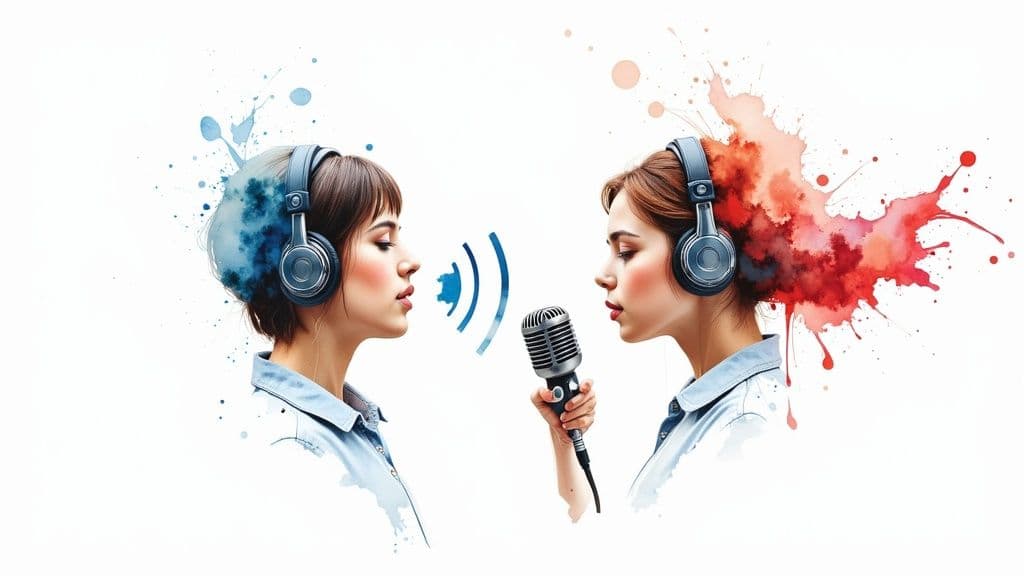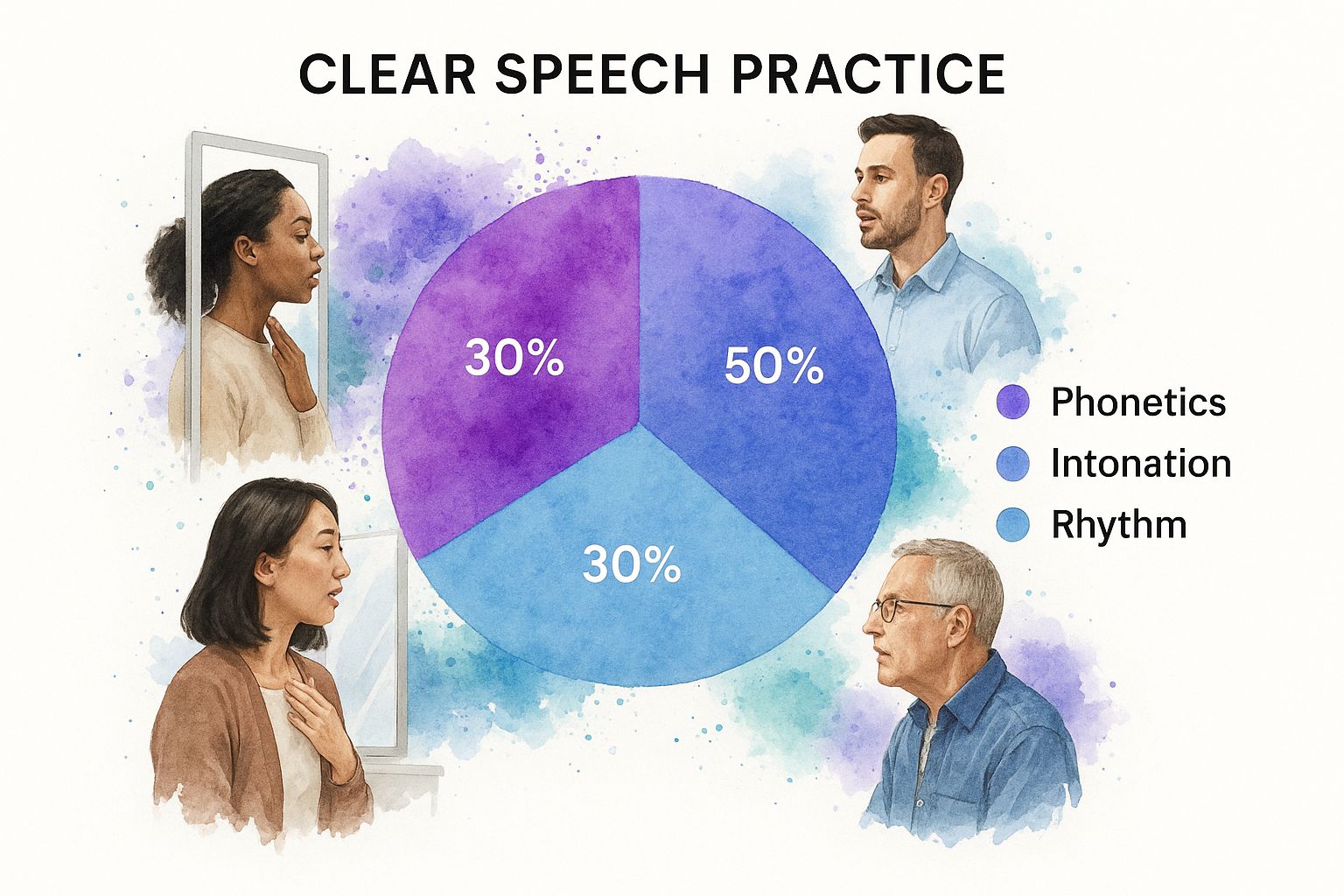How to Improve Accent in English: Tips for Clear Speech
Learn how to improve accent in English with practical tips on pronunciation and intonation. Boost your confidence and speak more clearly today!


When you start working on your English accent, the goal isn't to sound like a flawless native speaker. It's about achieving clear communication. The best way to get there is by zeroing in on the core parts of speech—phonetics, intonation, and rhythm—and shifting your mindset from "erasing" your accent to simply making yourself easier to understand.
Why 'Perfect' Is the Enemy of Clear Communication
So many people who want to improve their accent in English start with a huge misconception: the idea that they need to sound exactly like a native speaker. Let's get this straight right now—your goal isn't perfection. It's clarity. Chasing some idealized "perfect" accent is a surefire way to get frustrated and anxious, which can stall your progress before you even get started.
A much healthier and more effective way to think about it is to focus on being clearly understood. Your accent is part of your identity, and the objective is to refine it, not get rid of it. This small but powerful shift in perspective changes the whole game. It's no longer a battle against your own voice, but a process of honing your communication skills.
This visual breaks down the core pillars of clear speech—phonetics, intonation, and rhythm—which are the real foundation for any learner.
When you build your practice around these three elements, you create a solid base for intelligible speech without the pressure of trying to sound like someone you're not.

The True Foundations of a Clear Accent
If perfection isn't the goal, what should you be working on? The building blocks of clear speech are universal and much more practical. Let's unpack them.
- Phonetics: This is all about the mechanics of sound. You need to master English phonemes—those tiny units of sound like the 'th' in "think" or the 'r' in "right." It really comes down to training your mouth, tongue, and lips to form sounds that might be completely new to you.
- Intonation: This is the music of the language. It’s the natural rise and fall of your voice that conveys meaning and emotion. Just think about how your pitch goes up when you ask a question. Getting the intonation right makes your speech far more engaging and easy for others to follow.
- Rhythm: This is the natural flow and stress patterns of English. English is a stress-timed language, which means some syllables get more emphasis than others. Nailing this rhythm is absolutely crucial for sounding natural.
The real breakthrough happens when you stop trying to sound 'American' or 'British' and start focusing on sounding clear. Clarity is the universal standard that opens doors to effective communication, no matter where you are.
Overcoming Accent Anxiety
That pressure to sound perfect often leads to what’s known as accent anxiety. It’s that self-conscious feeling that makes you hesitant to speak up, which creates a huge barrier to practice and improvement. This is a common psychological hurdle, often driven by social pressures and a simple desire to fit in.
It might surprise you, but even native speakers feel this. A revealing study found that 46% of Britons believe their accent is a magnet for negative stereotypes, and 38% actually wish they could change it. This just goes to show that the desire to be understood and accepted is a universal human experience. You can check out the full study on accent perceptions over at Talk-Easy.com.
When you shift your focus from eliminating your accent to enhancing your clarity, you lower the stakes and make the whole learning process more enjoyable. This mindset frees you up to speak with confidence right from the start, and that’s the most important step of all.
Targeting Tricky Sounds with Phonetic Practice

Alright, now that we’ve established that clarity trumps perfection, it’s time to roll up our sleeves. The real work of refining your English accent happens at the sound-by-sound level—what linguists call phonemes. Every language has its own library of sounds, and let's be honest, English has a few that are notorious tripwires for learners.
This is where focused, deliberate phonetic practice makes all the difference. Think of it less like studying and more like physical therapy for your mouth. You're building new muscle memory in your tongue, lips, and jaw. Just like a pianist practices scales to make their fingers move effortlessly, you’re training your mouth to produce unfamiliar sounds automatically.
Master the Art of Minimal Pairs
One of the most powerful techniques I've seen work for countless students is drilling with minimal pairs. These are simply pairs of words that differ by only a single sound, and they are brilliant for sharpening both your listening and speaking skills.
They highlight the exact sounds that cause confusion. For example:
- The long 'ee' vs. the short 'i' (sheep vs. ship)
- The classic 'l' vs. 'r' (lice vs. rice)
- The dreaded 'th' vs. 's' (think vs. sink)
When you practice these pairs, you isolate the problem. Take "think" versus "sink." For the 'th' sound, you can physically feel your tongue gently touching your top teeth. For the 's' sound, your tongue is behind your teeth. This direct, physical feedback is what locks the new movement into your muscle memory.
To help you get started, here's a quick reference table for some of the most commonly confused English sounds. Try saying each pair aloud, really focusing on the physical difference in your mouth.
Commonly Confused English Phonemes Practice Chart
| Target Sound (IPA) | Minimal Pair Example 1 | Minimal Pair Example 2 | Practice Tip |
|---|---|---|---|
| /iː/ vs. /ɪ/ | beat / bit | sheep / ship | For /iː/ (beat), smile wide. For /ɪ/ (bit), your mouth is more relaxed. |
| /l/ vs. /r/ | light / right | collect / correct | For /l/, your tongue tip touches the ridge behind your top teeth. For /r/, it doesn't touch anything. |
| /θ/ vs. /s/ | thin / sin | mouth / mouse | For /θ/ (thin), gently place your tongue tip between your teeth. For /s/, keep your tongue behind them. |
| /v/ vs. /w/ | vest / west | vine / wine | For /v/, your top teeth touch your bottom lip. For /w/, your lips are rounded, with no teeth contact. |
Working through a chart like this, even for just a few minutes a day, trains your ear to notice subtle differences you might have previously missed and gives your mouth the workout it needs.
Use the IPA as Your Pronunciation Roadmap
The International Phonetic Alphabet (IPA) might look like a secret code at first, but it’s actually your most reliable map to accurate pronunciation. The standard English alphabet is notoriously inconsistent—think about the 'o' in go, to, and women. Each one is different!
The IPA solves this problem. Each symbol represents exactly one sound. No exceptions.
Using the IPA takes all the guesswork out of pronunciation. It gives you a consistent, accurate guide for any word, ensuring you’re practicing the correct sound every single time. This is a game-changer when you're figuring out how to improve your accent in English.
For example, if you look up the word "read" in a dictionary, you'll see two IPA spellings: /riːd/ (present tense, like "I read every day") and /rɛd/ (past tense, like "I read it yesterday"). The IPA instantly clarifies the different vowel sounds, something the spelling alone can't do.
You don't need to memorize the whole chart. Just start by learning the symbols for the specific English sounds you find most difficult. This turns the IPA from an intimidating academic chart into your personal, practical toolkit for building a clearer, more confident accent. For real-time coaching on these specific sounds, a platform like Talk-Easy can provide the instant feedback you need to ensure your practice is actually paying off.
Finding the Natural Music of English Speech

Once you’ve started to nail individual sounds, the next real leap forward in improving your English accent is getting a feel for its natural music. If sounds are the individual notes, then intonation, stress, and rhythm are the melody that turns them into a cohesive song. This is the secret ingredient that transforms robotic, word-by-word speech into a smooth, natural flow.
Just think about how you express yourself in your own language. Your voice naturally rises at the end of a question, right? And when you get excited, your pitch and pace pick up. That's the heart of intonation—the rise and fall of your voice that signals emotion and grammatical cues.
Getting this right is less about memorizing strict rules and more about developing an ear for the tune. It’s about hearing the underlying melody in a sentence and learning to hum it yourself. Without this musicality, even perfectly pronounced words can sound flat and make it hard for people to follow what you're saying.
Mastering Sentence Stress and Rhythm
Here's something crucial to understand: English is a stress-timed language. This just means that in any sentence, we emphasize some words more than others, creating a distinct rhythm. The "important" words—nouns, main verbs, adjectives, adverbs—get the stress. The little grammatical words like 'a,' 'the,' 'in,' and 'is' are usually unstressed and squished between the important ones.
Take a simple sentence like this:
"I went to the store to buy some milk."
A native speaker doesn’t give each word equal time or weight. Instead, their speech bounces from one stressed word to the next (went, store, buy, milk), creating a kind of beat. A common mistake for learners is giving every single word the same amount of emphasis, which is a dead giveaway of a non-native accent and can sound quite jarring.
The key takeaway is to focus your energy on the words that carry the most meaning. When you learn to punch those content words and glide over the function words, your speech will instantly sound more fluent and natural.
The Power of Shadowing Your Way to Fluency
So, how do you actually learn this musicality? One of the most powerful techniques I know is shadowing. It’s pretty straightforward: you listen to a native speaker and repeat what they say in real-time, just a fraction of a second behind them.
But don't mistake this for mindless parroting. Shadowing is an intense, active listening exercise that forces your brain and mouth to match the speaker's:
- Pace: Are they speaking quickly or taking their time?
- Pitch: Notice where their voice rises and where it falls.
- Pauses: Where do they naturally stop for a breath?
- Stress: Which words are they hitting the hardest?
This method bypasses the overthinking part of your brain and helps you absorb the rhythm of English on a much deeper level. It literally trains the muscles in your mouth to move in sync with what you hear, building the muscle memory you need for natural-sounding speech.
To make shadowing work, you need clear, high-quality audio. If this sounds like a technique you want to try, I’d also recommend checking out our guide on how to improve English listening skills, because you can't shadow what you can't hear clearly.
Start small. Find a short audio clip from a podcast or an audiobook. Listen to it once just to get the gist, then play it again and try to speak along. It will feel incredibly awkward at first, and you will miss words. That’s totally fine. The goal isn't word-for-word perfection; it’s to capture the overall flow and melody. Try recording yourself and comparing it to the original—it's an eye-opening way to spot where your rhythm and intonation differ so you can start closing the gap.
Putting Your Accent Skills into Practice
Knowing the theory behind phonetics and intonation is a great start, but the real magic happens when you bring those skills into actual conversations. It’s time to take what you've learned off the page and weave it into your daily life.
The key is to create practice routines that feel natural, not like a chore. Moving from isolated drills to flowing speech is a huge leap, but it's the most important one for improving your accent. Don't aim for perfection right away—just be consistent.
Make Reading Aloud a Daily Habit
One of the easiest and most powerful things you can do is simply read aloud every day. Grab an article, a blog post, or a few pages from a book you find interesting.
Your goal isn't just to understand the words, but to focus on how you're saying them. Pay close attention to linking sounds between words. Native speakers don't pronounce every single word separately; they blend them together. For example, "an apple" sounds more like "anapple," and "turn it off" becomes "turnitoff." Mastering these connections is what makes your speech sound smooth and natural.
The Game-Changing Habit of Self-Recording
I know, it can feel a little awkward at first, but recording yourself is an incredible tool. You can’t fix what you can’t hear, and the voice in your head often sounds very different from the voice others hear. This simple act turns you into your own accent coach, no pressure involved.
Here’s a simple routine to try:
- Find a short audio clip of a native speaker. A minute or two from a podcast or a news report works perfectly.
- Record yourself reading the same text or just summarizing what you heard.
- Listen to both recordings one after the other.
What do you notice? Is your intonation a bit flatter? Are you stressing different words? This side-by-side comparison gives you immediate, personalized feedback and helps you zero in on exactly what to work on next.
The point of recording yourself isn't to be self-critical. It's about building awareness. When you listen objectively, you start catching the subtle patterns in rhythm and pitch that you can then consciously practice.
Find a Partner for Real-World Feedback
At the end of the day, nothing beats practicing in a real conversation. Finding a language exchange partner gives you the kind of interactive feedback that studying alone just can't provide. They can tell you on the spot when something you say isn't quite clear, which is invaluable for breaking through a learning plateau. If you need some ideas on where to look, check out our guide on finding English conversation practice online.
This kind of guided practice is proven to get results. A 2019 systematic review found that people in accent modification programs consistently improved their pronunciation, intonation, and rhythm. These gains led directly to being understood more easily, feeling more confident, and having less anxiety when speaking. You can read more about the research behind accent coaching on 800-language.com. Getting that honest, constructive feedback is what turns theory into real progress.
Building Your Personal Accent Improvement Toolkit
If you’re serious about improving your English accent, consistency is everything. While drills are crucial, the secret to sticking with it is having the right resources ready to go. You need to build a small, powerful toolkit that makes daily practice feel less like a chore and more like a natural part of your routine.
This isn’t about hoarding dozens of apps you’ll never open. It’s about choosing a few tools you genuinely like and that fit your life, creating a system that keeps you moving forward.
Essential Digital Tools for Accent Practice
The right tech can give you instant feedback that used to require a private tutor. From phonetic breakdowns to AI-powered analysis, modern tools make it so much easier to zero in on your problem areas.
Let's start with the fundamentals.
- Mobile Pronunciation Apps: Find an app that uses voice recognition to give you on-the-spot feedback. Tools like ELSA Speak or Forvo are fantastic because you can hear a native speaker, record your own version, and get a score. It shows you exactly where you’re going wrong.
- Online Dictionaries with Audio: Stop guessing how to say a word. Use online dictionaries like Merriam-Webster or Collins Dictionary, which have audio clips for both American and British English. The real game-changer here is the International Phonetic Alphabet (IPA) transcription—it's your ultimate cheat sheet for mastering any sound.
- AI-Powered Platforms: Some platforms can now listen to you speak and give you a full report. They analyze your intonation, rhythm, and pacing, providing concrete data you can use to refine your delivery.
The best toolkit is the one you actually use. Find a mix of apps and sites that are easy and even fun to access. This way, you can turn any spare moment into a quick and productive practice session.
Curate Your Content for Active Learning
The content you already enjoy can become your best practice material. The key is to switch from just passively listening to actively engaging with it. You can use authentic, real-world content to model your own speech. If you're looking for ways to do this, our guide on how to practice English conversation for free has some great strategies.
Here are a few content types to fold into your daily routine:
- YouTube Accent Coaches: Channels like Rachel's English (for American English) or ETJ English (for British) are invaluable. They offer detailed visual lessons, often with close-ups of the speaker's mouth, so you can see the physical mechanics of forming tricky sounds. That’s something you just can’t get from audio alone.
- Podcasts for Shadowing: Look for podcasts that have clear, steady speakers and provide full transcripts. This is the perfect setup for shadowing. You can listen, read along, and repeat what you hear, focusing on matching the host’s natural rhythm and intonation.
Answering Your Top Questions About Improving Your English Accent
As you start working on your English pronunciation, you're bound to have some questions. It’s totally normal. Let's walk through some of the most common ones I hear from learners, so you can set realistic goals and practice with confidence.
Getting your mindset right is half the battle. Knowing what to expect—the timeline, what a realistic outcome looks like, and where to put your energy—can save you a ton of frustration down the road.
How Long Does It Really Take?
There's no one-size-fits-all answer here. Your progress really depends on your starting point, your native language, and, most importantly, how often you practice. This isn't about cramming for a test; it's about building new muscle memory through steady, focused effort.
Most people who dedicate just 15-30 minutes of focused practice each day start to see and feel a real difference in their clarity and confidence within about three to six months. Remember, consistency is your best friend. Short, daily sessions will always beat long, infrequent ones.
Should I Aim for an American or British Accent?
Honestly? Neither. Unless you have a very specific reason for it, your goal shouldn't be to sound perfectly American or British. It should be to develop a clear, neutral accent that anyone can understand.
Think about it: most conversations in English around the world don't even involve a native speaker. While there are about 1.35 billion English speakers, only around 370 million of them are native. This means your real audience is global. You can dive deeper into these English language statistics at Kylian.ai.
Your accent is part of who you are. The goal isn't to erase it. It's about refining your pronunciation so you can be easily understood by anyone, which cuts down on confusion and makes you feel more confident.
Can I Completely Lose My Native Accent?
For most adults, losing your accent entirely is incredibly difficult—and frankly, it's not a necessary goal. Trying to sound like a "perfect" native speaker often just leads to a lot of stress and anxiety.
A much healthier way to look at it is accent modification, not elimination. You're simply softening the parts of your native accent that might make it tricky for others to understand your English. This lets you keep your unique voice while making sure your message always comes through loud and clear. That's what real success looks like.
Ready to turn those questions into confident conversations? Talk-Easy gives you the daily, real-time practice you need to build a clearer accent. Our AI tutors provide instant, friendly feedback in just 15 minutes a day, fitting perfectly into any schedule. Start speaking more clearly today.